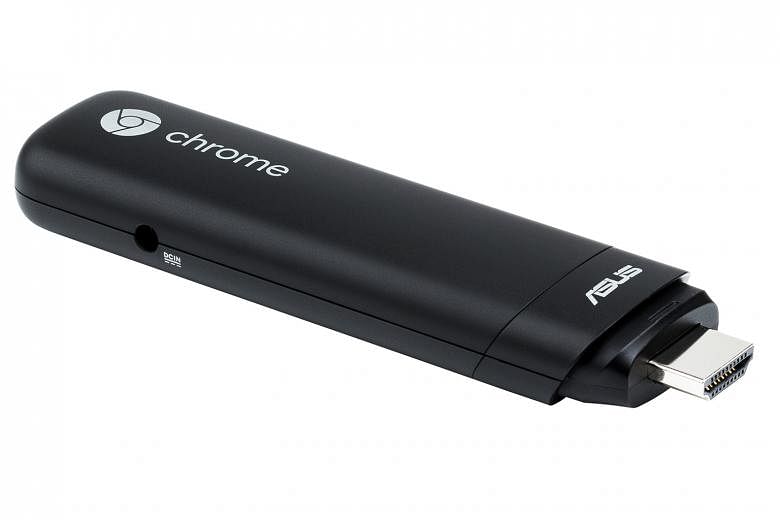The Asus Chromebit CS10 turns any display with a HDMI port into a computer.
Like the Intel Compute Stick that I tested last year, the Chromebit looks like a giant USB flash drive. Plug it into a display's HDMI port, connect its proprietary power cable and, within a minute, you could be working on a document.
This sounds like a good idea, especially for travellers. They could leave their laptops at home and use the Chromebit with the hotel room's TV. Since the Chromebit is a fully functional computer, albeit one that runs Google's lightweight Chrome OS operating system instead of Windows, you could use it to stream videos from Netflix, browse the Internet or work on a presentation.
But I quickly realised that you still need a keyboard and a mouse to control the Chromebit, which severely diminishes its appeal as a portable computer. Bluetooth 4.0 is supported, though you could also use USB peripherals with a USB hub connected to the Chromebit's single USB 2.0 port.
As someone who has experienced the frustration of trying to plug a dongle into a port in an awkward location, I was pleased that the Chromebit includes a bendable HDMI extension for hard-to-reach HDMI ports.
-
TECH SPECS
-
PRICE: $179
PROCESSOR: Rockchip RK3288-C
GRAPHICS: Mali T764
RAM: 2GB
STORAGE: 16GB
CONNECTIVITY: USB 2.0, HDMI
-
RATING
-
FEATURES: 3/5
DESIGN: 4/5
PERFORMANCE: 3/5
VALUE FOR MONEY: 3/5
OVERALL: 3/5
The Chromebit sends audio via HDMI, which can be an issue if the display does not have built-in speakers or a headphone jack.
Unlike the Intel Compute Stick, the Chromebit does not have a memory card slot to increase its 16GB internal storage.
Chrome OS boots up in a few seconds. It automatically downloads updates when connected to the Internet. A Google account is required, though you can also sign in as a guest. Bundled with the Chromebit is 100GB of Google Drive storage for two years for your Google account.
Most of the apps in the Chrome Web Store are web-based and free. In other words, expect indie games, like the ones found on Android, rather than PC titles.
The Rockchip processor in the Chromebit is about as fast as a mid-range mobile CPU. I could have multiple tabs open in the Chrome OS' browser interface without a hitch. However, YouTube videos seemed to stutter at 1080p resolution, even after buffering.
I was a bit alarmed by how warm the Chromebit became after a short session. It was almost too hot to touch. The Intel Compute Stick runs cool because of its built-in fan.
Because of the additional peripherals required, a Chromebook may be more convenient for those who need an inexpensive computer on the go. And if you just need to stream Netflix, the Google Chromecast is a smaller and cheaper dongle.
But I could see the Chromebit powering a public kiosk, especially as Chrome OS actually has a special kiosk mode for this purpose.
Vincent Chang
• Verdict: The Chromebit is sleeker and cheaper than the Intel Compute Stick. But it is still not as portable as a budget laptop. It could work as a kiosk or a budget desktop computer.

